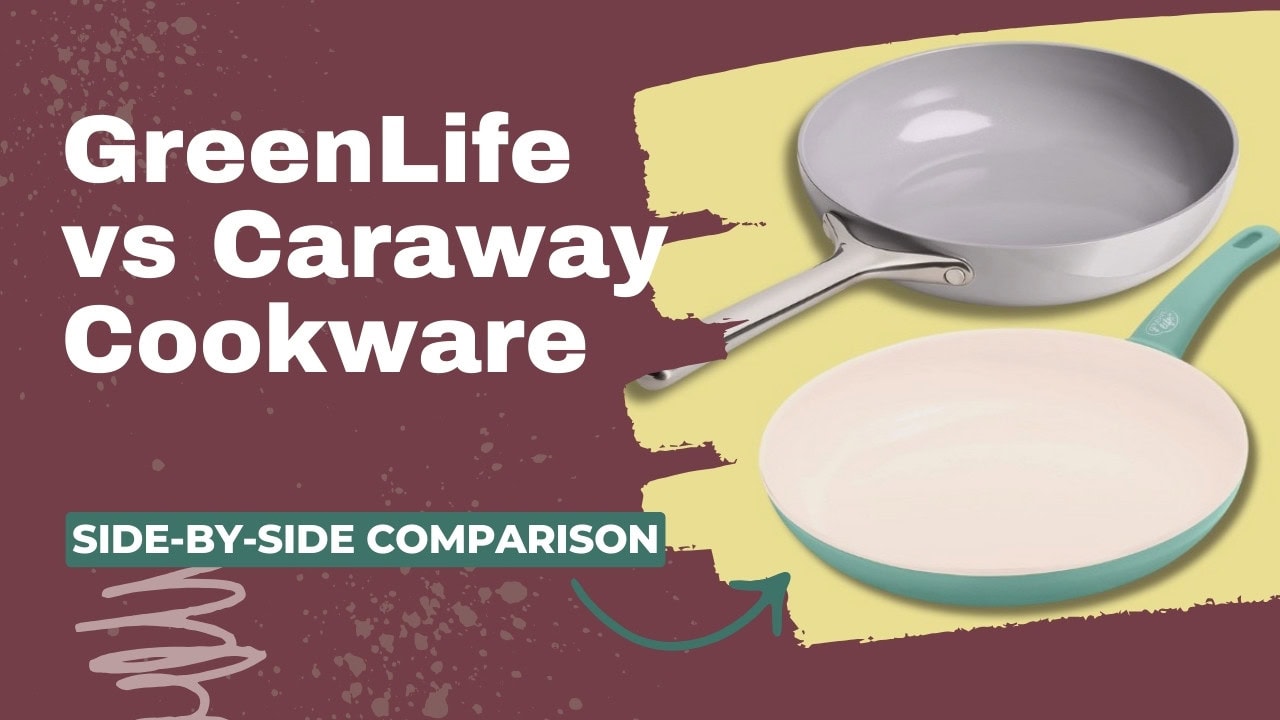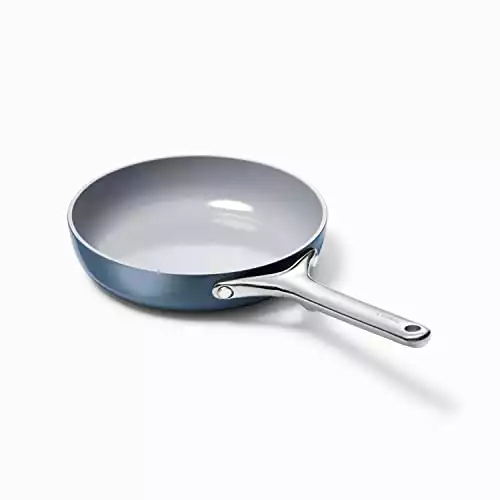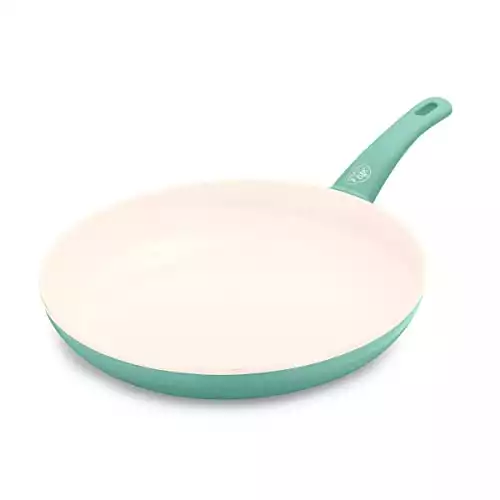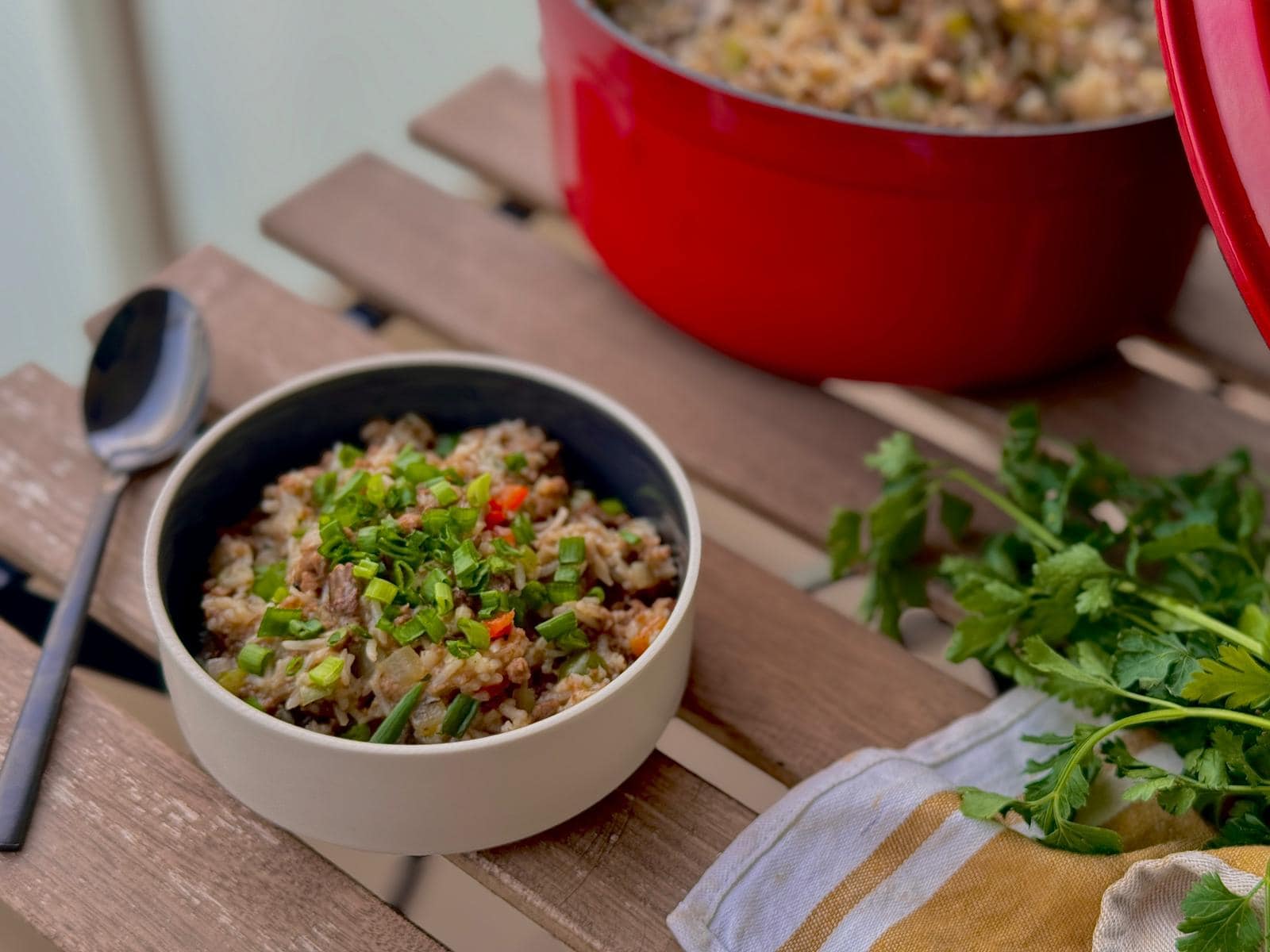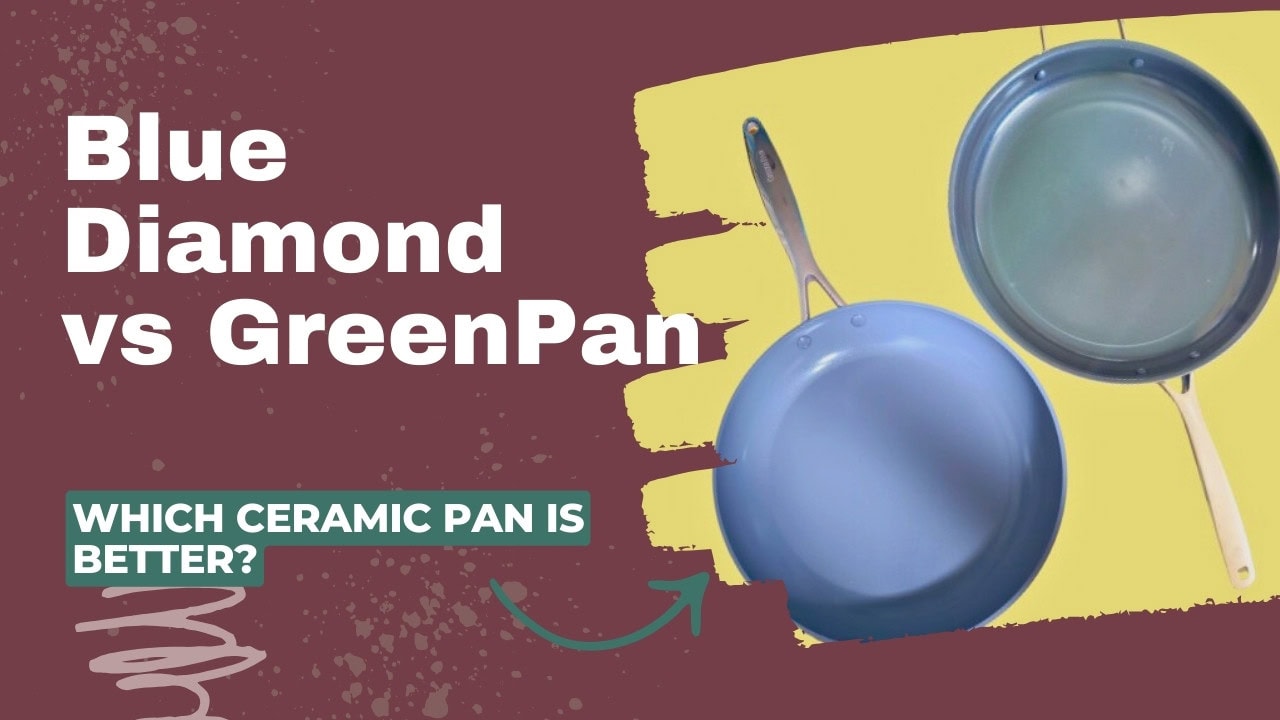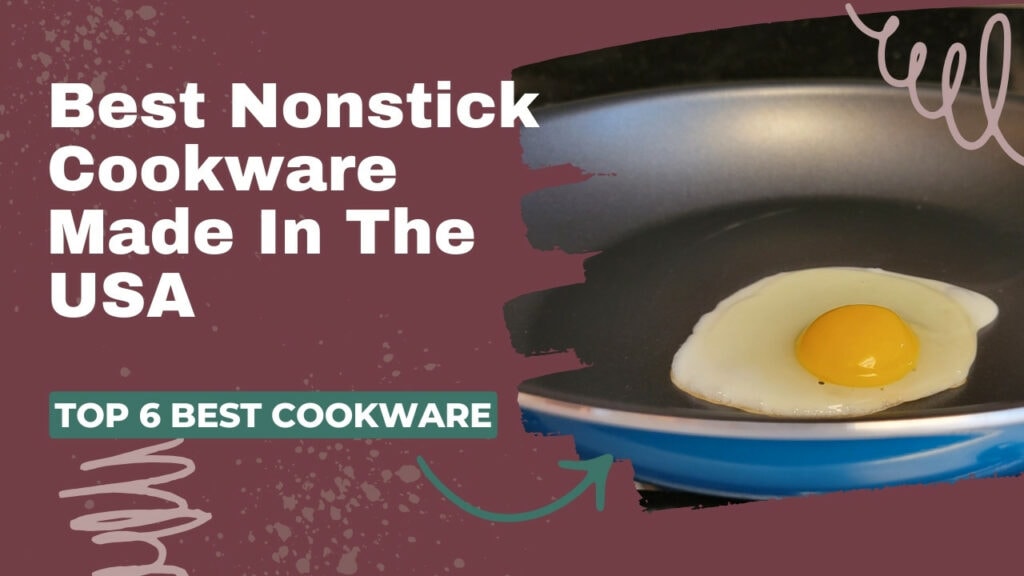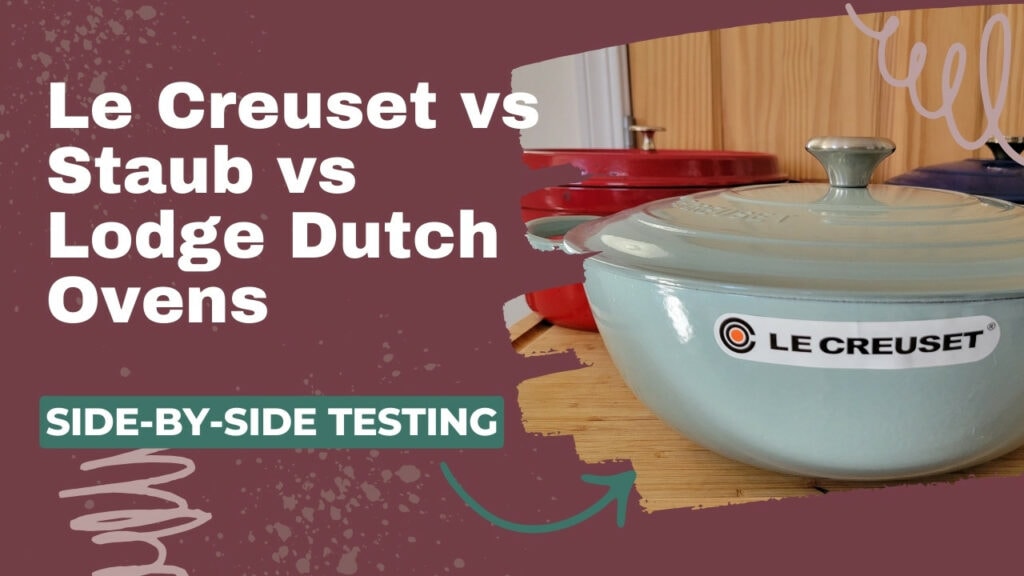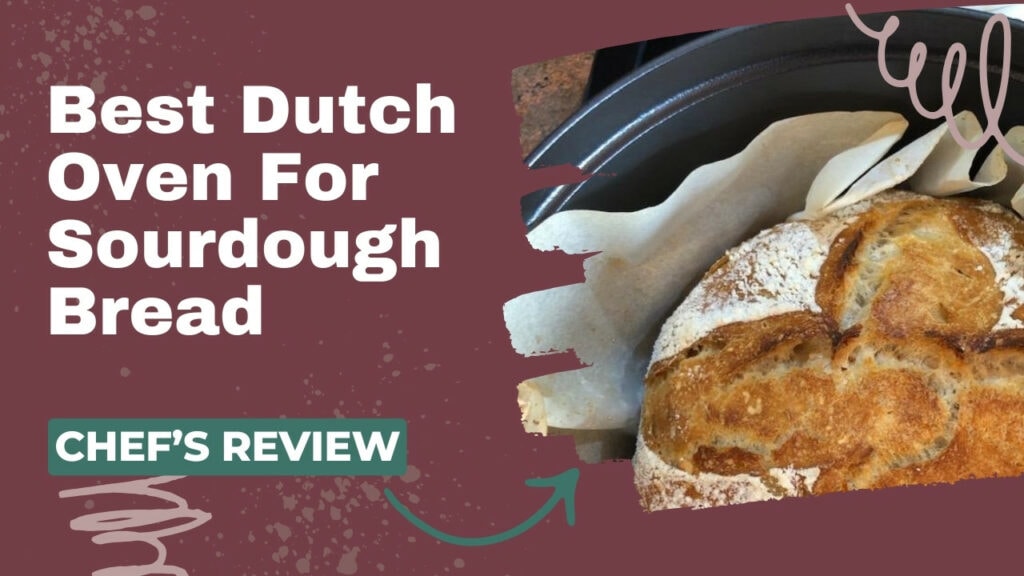Caraway is a boutique brand of ceramic cookware – and one of the most expensive you can buy.
I tested a Caraway fry pan against a much cheaper brand – GreenLife. The food I cooked came out much better in the Caraway pan. But since the coating will only last a little longer in an expensive ceramic pan than a cheap one, it might not be worth the cost.
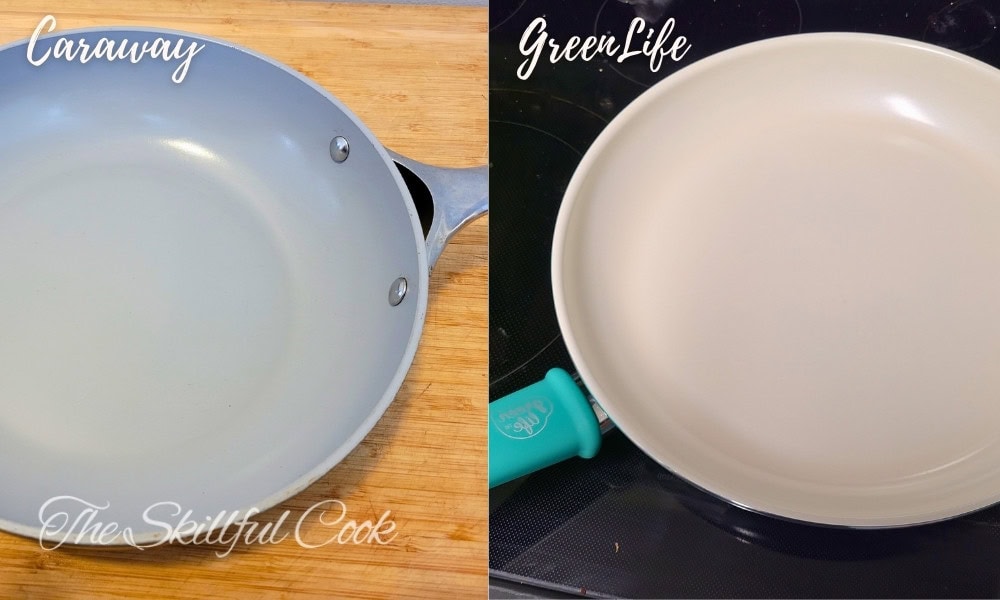
GreenLife vs Caraway Side-by-Side Comparison
Caraway
Our rating:
78/100
Size:
10.5” Frying Pan
Length:
18”
Cooking Surface:
8”
Weight:
2.8 pounds
Oven-Safe:
550°F (287°C)
Coating:
Proprietary Ceramic
Best For:
Everyday Cooking
Country of Origin:
China 🇨🇳 / Vietnam 🇻🇳
GreenLife
Our rating:
64/100
Size:
12” Frying Pan
Length:
19”
Cooking Surface:
9.5”
Weight:
2.27 pounds
Oven-Safe:
350°F (176°C)
Coating:
Thermolon Ceramic
Best For:
Eggs, New Cooks
Country of Origin:
China 🇨🇳
The Winner: Caraway Nonstick Ceramic Pan
The Caraway nonstick ceramic fry pan is heavier and more expensive than the GreenLife Soft Grip. However, it delivers a better cooking performance and feels like a sturdy, quality product.
Pros
Cons
The Runner Up: GreenLife Soft Grip 12” Frying Pan
Pros
Cons
Main Differences Between Caraway and GreenLife Cookware
For this product review, we tested the 12” GreenLife SoftGrip fry pan and compared it to the 10.5” Caraway ceramic fry pan.
Why Is The Caraway Nonstick Ceramic Pan the Winner?
I love a budget buy as much as the next person, but I believe in balancing price with quality. The Caraway Nonstick pan simply out-cooked its cheaper competitor.
Cooking Performance
The Caraway pan scores major points from me for being oven-safe to 550°F (288°C). The GreenLife pan is only oven-safe to 350°F (176°C) because of its Bakelite plastic handle, which can give off nasty fumes if overheated.
In my test kitchen, I boil water, flip pancakes, cook eggs, and sear protein on every pan that I test.

The GreenLife Soft Grip took significantly longer to boil water and had more hot/cold spots than the Caraway pan. I was impressed by how Caraway’s heavier aluminum pan heated up quickly and then held that heat. As it boiled the water for 15 minutes, the water bubbled evenly and an infrared thermometer showed consistent temperatures across the edges and center of the pan.
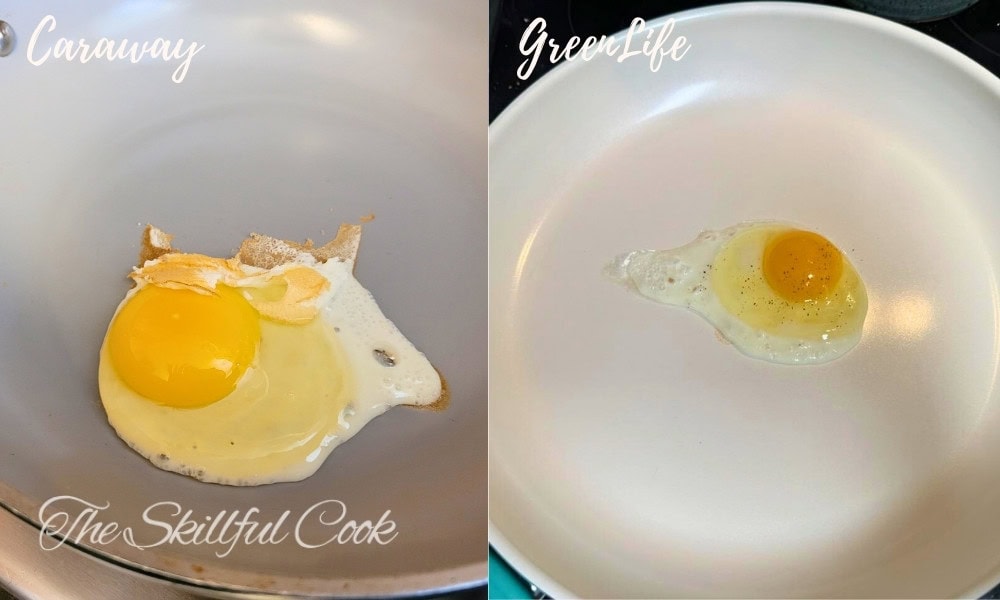
The GreenLife pan did a better job cooking eggs with no oil. It also released the pancakes and chicken very well with little to no oil. That said, it steamed chicken breast instead of searing it. So – especially because it can’t be used on high heat – this wouldn’t be my go-to pan for proteins.
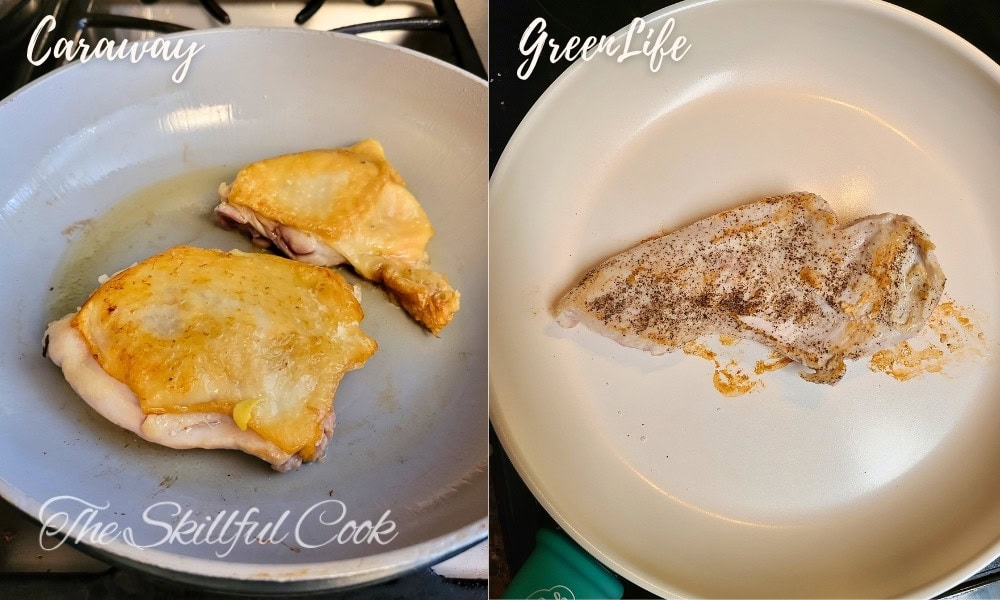
The Caraway pan has a textured, mineral-reinforced coating, and the literature that came with the pan suggested using oil to butter to cook in it. But I found I had to use a significant amount of cooking fat to keep eggs from sticking – nearly as much as in a pan that’s not “nonstick.”
The GreenLife pan is better for eggs or delicate foods like fish. The Caraway pan is a better all-around cooking pan, doing an excellent job browning chicken, cooking pancakes, and boiling liquid!
Build Quality
Caraway is a thick pan, with 4mm of aluminum beneath the coating. There is very little chance that, used properly, this pan will warp. It’s a workhorse. The handle is attached with a wide V-shape with two rivets.
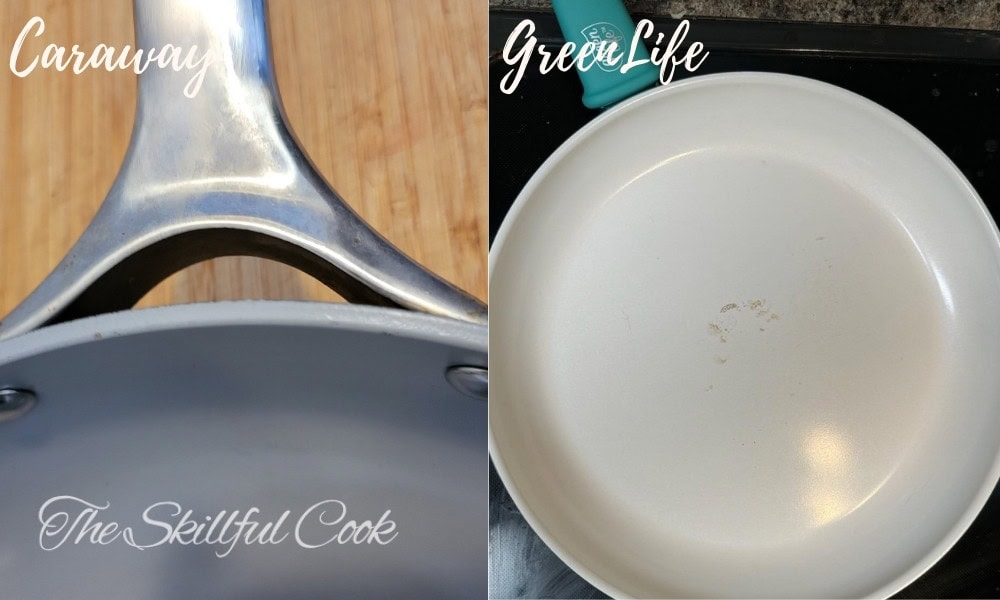
The biggest “pro” for me with the lighter GreenLife Soft Grip pan was its lack of rivets on the interior of the pan. Rivets make pans harder to clean by catching bits of food or oil.
Both pans sat nice and flat on the stovetop. The Caraway pan is definitely sturdier and better-made. In fact, the heavy pan body could probably outlast its ceramic coating by a decade or two.
Design and Comfort
The GreenLife Soft Grip is a pretty pan. It comes in multiple bright colors and felt like a little piece of Spring was sitting on my stovetop. But Caraway looks like it said to the ceramic pan market, “You think you’re pretty? Hold my blossoms.” Caraway pans have a unique and recognizable design, dressed in bright exterior paint. The interiors are soft gray.
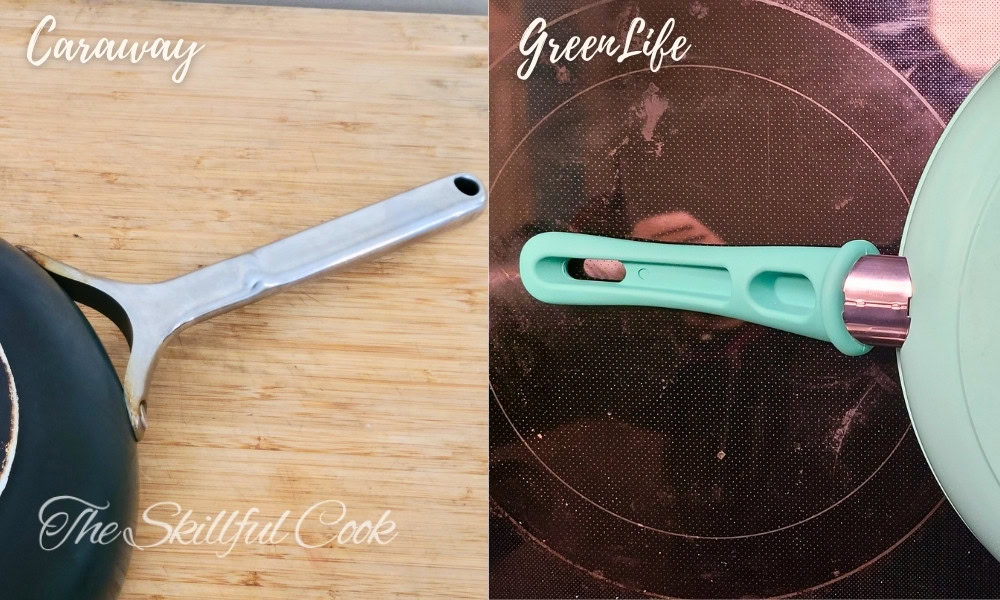
GreenLife Soft Grip features a Bakelite plastic handle. It’s not amazingly comfortable, but neither is the stainless steel handle on the Caraway Pan. Both handles got warm a bit on an electric stove, but it isn’t much of an issue. On a gas stove, the Caraway handle can get hot and the GreenLife plastic handle can burn.
Caraway’s lid comes with a beautiful long handle, rather than the small knob you traditionally see on pan lids.
I wish both pans had a helper handle. That’s always #1 on my wishlist as it is because full pans can get heavy. GreenLife is a little easier to pick up because of its lighter weight, so if you have grip issues, keep in mind that GreenLife is over 5 ounces lighter straight out of the packaging.
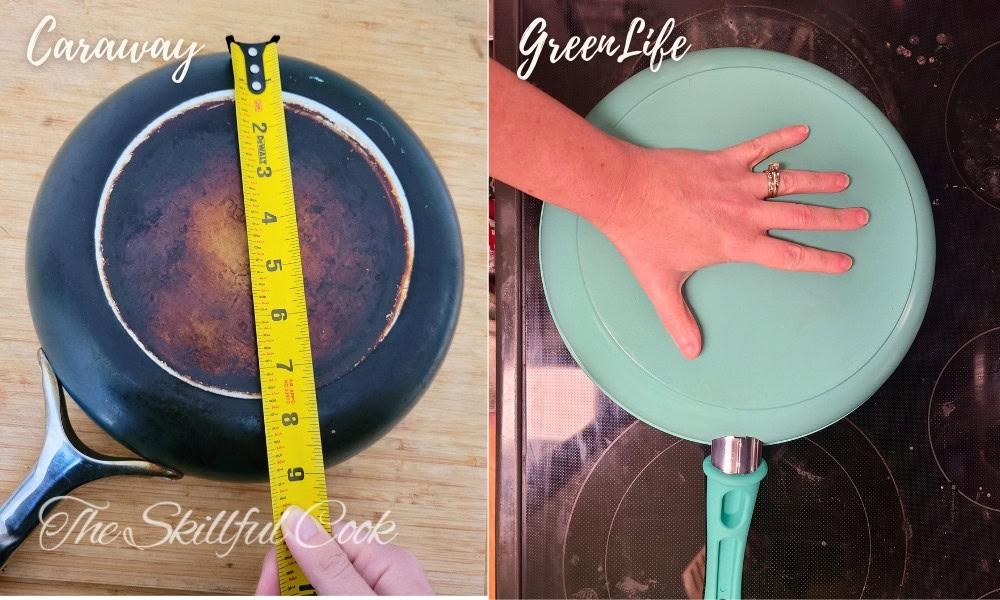
The GreenLife Soft Grip 12” frying pan only has a cooking surface of 9.5”. The smaller 10.5” Caraway has a cooking surface of 8”. I don’t know why all pans don’t list their cooking surface instead of the circumference of the top of the pan! Would be so helpful to know. The Caraway pan has deep sides, so its overall capacity is higher.
Versatility
I found the Caraway Ceramic pan to be more versatile than the GreenLife Soft Grip. Its deep sides made it useful for everything from pancakes to chili! I also found it to be a better one-pot pan, able to more easily go from stovetop to oven.
Caraway’s even heating and cooking gave me more confidence while cooking than the GreenLife pan. The hot/cold spots when using the GreenLife pan were so pronounced. I certainly don’t want to serve my family food that was both overdone and underdone!
Ease of Use and Maintenance
GreenLife doesn’t have rivets inside the pan, which made it a little easier to clean. Overall, both pans were cleaned easily with just warm water, soap, and a soft cloth. The Caraway pan does collect polymerized oil on the outside, which causes dark brown stains. You can scrub these off with Bar Keeper’s Friend and a little elbow grease.
📝 Ceramic pans need to be handled carefully. Always remember to let the pans cool down before you wash them. Using metal utensils and/or using the dishwasher will make the pan’s ceramic coating chip. It will also wear out the nonstick coating more quickly.
Neither of these ceramic fry pans needs to be seasoned like cast iron skillets. Avoid spray oils. They can bake on, leaving you with a sticky mess that is difficult to clean. Also, avoid low-smoke point oils (even if they aren’t sprays). These oils can also cause gummy polymerized oil residue.
Longevity and Warranty
Here’s the bad news: your ceramic pan is only going to be around for a few years, even in the best-case scenario. The coating just doesn’t last.
Based on the build quality, I don’t expect GreenLife to outlast the more expensive Caraway.
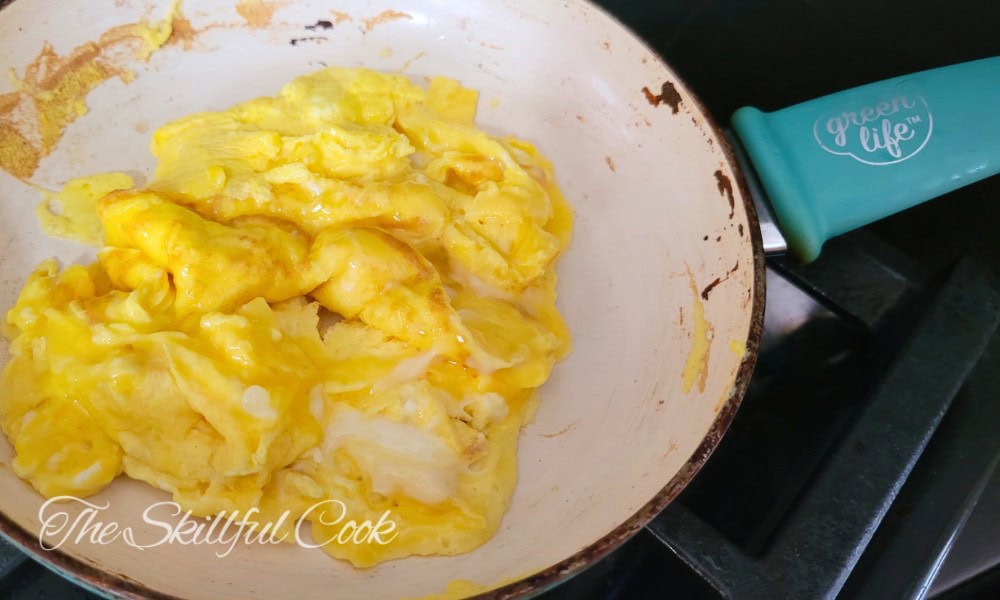
I borrowed a friend’s 3-year-old Caraway saute pan, and while it had its share of scratching and staining, it was still a pleasure to cook with. The Caraway test frying pan was over a year old and only had one scratch on the interior. I believe your first Caraway pan will be going strong while other consumers are on their 3rd GreenLife Soft Grip pan.

Let me let you in on my secret though- the way you care for your pan will affect how long the coating lasts more than exactly what the coating is made of. All the “diamond coating” in the world won’t make your pan last if you take it straight from the stove to the dishwasher, or use metal utensils on it.
Let’s talk about warranties.
GreenLife offers consumers a 2-year limited warranty that really only covers manufacturer defects. If your pan sticks within a few months, or you have an oopsy and chip it in the dishwasher, it is up to the company to decide if a damaged pan falls under its warranty. GreenLife has a 60-day return policy, but only on unused products.
Caraway’s limited warranty is good for only a year. Like GreenLife, it only covers manufacturer defects. However, Caraway has a 30-day “return if you’re not satisfied” offer. I recommend using this pan frequently in the first 30 days of ownership to make sure you like it. Don’t let it sit in its box for 2 months and before you test it and discover it’s not for you.
Price and Availability
GreenLife Soft Grip pans are available at mass merchandisers like Walmart and Target, as well as on Amazon. Caraway is also available on Amazon and can be ordered through stores like Macy’s or Williams-Sonoma. If you’re lucky, you may find Caraway at Target in your area.
Caraway is on the high end of the price range for ceramic pans. GreenLife is one of the cheaper options, coming in at nearly a fourth of the price of Caraway. Do keep in mind that Caraway’s price includes a lid, while GreenLife is available with or without. A skillet with a lid will increase the GreenLife price by around 10 dollars, making it a third of the price of Caraway.
Health and Safety Considerations
Most of my concerns with GreenLife Soft Grip come from its use of a bakelite handle. If the handle overheats, it can release toxic and horrible-smelling fumes. Gas stove users have reported that the handle burns even on low heat, though I did not experience this problem. Caraway’s stainless steel handle is safe even at a higher heat.

GreenLife states the food surface of the pans is California Prop 65 compliant, but lists chemicals of potential concern that “may be present in substrate layers” (check out GreenLife’s statement).
These layers should not come in contact with your food unless the coating is damaged.
Caraway publishes its California Prop 65 compliance results, which I love. I’m a “seeing is believing” person, so just seeing the official results goes a long way to ease my mind. It also shares its California AB-1200 materials, which include any chemicals or metals that may be of concern and present in its product.
Ceramic-coated pans are made without “forever chemicals,” aka PFAS (which is found in Teflon). Both these pans are also lead and cadmium-free. They are considered “most likely safe” by most experts. This technology is new, however, so we don’t know everything about its long-term effects.
Our in-depth guide to ceramic cookware dives more deeply into safety and what you need to know about ceramic cookware.
There is concern that titanium and quartz nanoparticles from some scratched ceramic coatings “can penetrate lung tissue more readily than larger particles.”
Please remember to replace your ceramic pans if the coating becomes chipped or deeply scratched.
Company and Environmental Impact
GreenLife pans are made by The Cookware Company and manufactured in China. The company has been accused of “greenwashing” by several sources. The company makes many claims about its cookware, such as that its coating creates 60% less carbon than traditional coatings in the curing phase” and that it uses recyclable packaging. I do appreciate that the company wholesale avoids using PFAS in its products.
Caraway also claims that it uses recycled paper in its packaging and that its “mineral-based coating releases 60% less CO2 into the environment”. Unfortunately, there’s not much third-party verification of these claims. Caraway’s 1-year warranty also makes me wonder how much faith it has in its product’s ability to hold up over time.
Both pans will end up in the landfill sooner, rather than later because ceramic pans simply can’t compare to the longevity of something like enameled cast iron.
Conclusion
When you compare GreenLife and Caraway pans, Caraway’s nonstick ceramic pan is the clear winner in my book. It’s more versatile and durable and simply cooks better-tasting food. But you’ll have to pay about three times more for it than a GreenLife pan. If you’re not totally sold on ceramic cookware, you can get a top-of-the-line carbon steel pan that will last forever for the same price as Caraway.
The GreenLife pan is a nice, affordable option for young adults heading off to college, or moving into their first apartment. My mom has one that she keeps in her RV for light use while camping.
If you’re looking for a pan just to make eggs for breakfast every now and again, I recommend you get the more affordable GreenLife Soft Grip pan.

